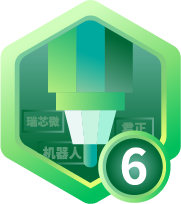基于opencv实战眼睛控制鼠标
如何用眼睛来控制鼠标?一种基于单一前向视角的机器学习眼睛姿态估计方法。在此项目中,每次单击鼠标时,我们都会编写代码来裁剪你们的眼睛图像。使用这些数据,我们可以反向训练模型,从你们您的眼睛预测鼠标的位置。在开始项目之前,我们需要引入第三方库。

For monitoring web camera and performing image minipulations
import cv2
For performing array operations
import numpy as np
For creating and removing directories
import os
import shutil
For recognizing and performing actions on mouse presses
from pynput.mouse import Listener
首先让我们了解一下Pynput的Listener工作原理。pynput.mouse.Listener创建一个后台线程,该线程记录鼠标的移动和鼠标的点击。这是一个简化代码,当你们按下鼠标时,它会打印鼠标的坐标:
from pynput.mouse import Listener
def on_click(x, y, button, pressed):
"""
Args:
x: the x-coordinate of the mouse
y: the y-coordinate of the mouse
button: 1 or 0, depending on right-click or left-click
pressed: 1 or 0, whether the mouse was pressed or released
"""
if pressed:
print (x, y)
with Listener(on_click = on_click) as listener:
listener.join()
现在,为了实现我们的目的,让我们扩展这个框架。但是,我们首先需要编写裁剪眼睛边界框的代码。我们稍后将在on_click函数内部调用此函数。我们使用Haar级联对象检测来确定用户眼睛的边界框。你们可以在此处下载检测器文件,让我们做一个简单的演示来展示它是如何工作的:
import cv2
Load the cascade classifier detection object
cascade = cv2.CascadeClassifier("haarcascade_eye.xml")
Turn on the web camera
videocapture = cv2.VideoCapture(0)
Read data from the web camera (get the frame)
, frame = video_capture.read()
Convert the image to grayscale
gray = cv2.cvtColor(frame, cv2.COLOR_BGR2GRAY)
Predict the bounding box of the eyes
boxes = cascade.detectMultiScale(gray, 1.3, 10)
Filter out images taken from a bad angle with errors
We want to make sure both eyes were detected, and nothing else
if len(boxes) == 2:
eyes = []
for box in boxes:
Get the rectangle parameters for the detected eye
x, y, w, h = box
# Crop the bounding box from the frame
eye = frame[y:y + h, x:x + w]
# Resize the crop to 32x32
eye = cv2.resize(eye, (32, 32))
# Normalize
eye = (eye - eye.min()) / (eye.max() - eye.min())
# Further crop to just around the eyeball
eye = eye[10:-10, 5:-5]
# Scale between [0, 255] and convert to int datatype
eye = (eye * 255).astype(np.uint8)
# Add the current eye to the list of 2 eyes
eyes.append(eye)- 1
- 2
- 3
- 4
- 5
- 6
- 7
- 8
- 9
- 10
- 11
- 12
- 13
Concatenate the two eye images into one
eyes = np.hstack(eyes)
现在,让我们使用此知识来编写用于裁剪眼睛图像的函数。首先,我们需要一个辅助函数来进行标准化:
def normalize(x):
minn, maxx = x.min(), x.max()
return (x - minn) / (maxx - minn)
这是我们的眼睛裁剪功能。如果发现眼睛,它将返回图像。否则,它返回None:
def scan(imagesize=(32, 32)):
, frame = video_capture.read()
gray = cv2.cvtColor(frame, cv2.COLOR_BGR2GRAY)
boxes = cascade.detectMultiScale(gray, 1.3, 10)
if len(boxes) == 2:
eyes = []
for box in boxes:
x, y, w, h = box
eye = frame[y:y + h, x:x + w]
eye = cv2.resize(eye, image_size)
eye = normalize(eye)
eye = eye[10:-10, 5:-5]
eyes.append(eye)
return (np.hstack(eyes) * 255).astype(np.uint8)
else:
return None
现在,让我们来编写我们的自动化,该自动化将在每次按下鼠标按钮时运行。(假设我们之前已经root在代码中将变量定义为我们要存储图像的目录):
def on_click(x, y, button, pressed):
If the action was a mouse PRESS (not a RELEASE)
if pressed:
Crop the eyes
eyes = scan()
if not eyes is None:
Save the image
filename = root + "{} {} {}.jpeg".format(x, y, button)
cv2.imwrite(filename, eyes)
现在,我们可以回忆起pynput的实现Listener,并进行完整的代码实现:
import cv2
import numpy as np
import os
import shutil
from pynput.mouse import Listener
root = input("Enter the directory to store the images: ")
if os.path.isdir(root):
resp = ""
while not resp in ["Y", "N"]:
resp = input("This directory already exists. If you continue, the contents of the existing directory will be deleted. If you would still like to proceed, enter [Y]. Otherwise, enter [N]: ")
if resp == "Y":
shutil.rmtree(root)
else:
exit()
os.mkdir(root)
Normalization helper function
def normalize(x):
minn, maxx = x.min(), x.max()
return (x - minn) / (maxx - minn)
Eye cropping function
def scan(imagesize=(32, 32)):
, frame = video_capture.read()
gray = cv2.cvtColor(frame, cv2.COLOR_BGR2GRAY)
boxes = cascade.detectMultiScale(gray, 1.3, 10)
if len(boxes) == 2:
eyes = []
for box in boxes:
x, y, w, h = box
eye = frame[y:y + h, x:x + w]
eye = cv2.resize(eye, image_size)
eye = normalize(eye)
eye = eye[10:-10, 5:-5]
eyes.append(eye)
return (np.hstack(eyes) * 255).astype(np.uint8)
else:
return None
def on_click(x, y, button, pressed):
If the action was a mouse PRESS (not a RELEASE)
if pressed:
Crop the eyes
eyes = scan()
If the function returned None, something went wrong
if not eyes is None:
Save the image
filename = root + "{} {} {}.jpeg".format(x, y, button)
cv2.imwrite(filename, eyes)
cascade = cv2.CascadeClassifier("haarcascade_eye.xml")
video_capture = cv2.VideoCapture(0)
with Listener(on_click = on_click) as listener:
listener.join()
运行此命令时,每次单击鼠标(如果两只眼睛都在视线中),它将自动裁剪网络摄像头并将图像保存到适当的目录中。图像的文件名将包含鼠标坐标信息,以及它是右击还是左击。
这是一个示例图像。在此图像中,我在分辨率为2560x1440的监视器上在坐标(385,686)上单击鼠标左键:

级联分类器非常准确,到目前为止,我尚未在自己的数据目录中看到任何错误。现在,让我们编写用于训练神经网络的代码,以给定你们的眼睛图像来预测鼠标的位置。
import numpy as np
import os
import cv2
import pyautogui
from tensorflow.keras.models import
from tensorflow.keras.layers import
from tensorflow.keras.optimizers import
现在,让我们添加级联分类器:
cascade = cv2.CascadeClassifier("haarcascade_eye.xml")
video_capture = cv2.VideoCapture(0)
正常化:
def normalize(x):
minn, maxx = x.min(), x.max()
return (x - minn) / (maxx - minn)
捕捉眼睛:
def scan(imagesize=(32, 32)):
, frame = video_capture.read()
gray = cv2.cvtColor(frame, cv2.COLOR_BGR2GRAY)
boxes = cascade.detectMultiScale(gray, 1.3, 10)
if len(boxes) == 2:
eyes = []
for box in boxes:
x, y, w, h = box
eye = frame[y:y + h, x:x + w]
eye = cv2.resize(eye, image_size)
eye = normalize(eye)
eye = eye[10:-10, 5:-5]
eyes.append(eye)
return (np.hstack(eyes) 255).astype(np.uint8)
else:
return None
让我们定义显示器的尺寸。你们必须根据自己的计算机屏幕的分辨率更改以下参数:
Note that there are actually 2560x1440 pixels on my screen
I am simply recording one less, so that when we divide by these
numbers, we will normalize between 0 and 1. Note that mouse
coordinates are reported starting at (0, 0), not (1, 1)
width, height = 2559, 1439
现在,让我们加载数据(同样,假设你们已经定义了root)。我们并不在乎是单击鼠标右键还是单击鼠标左键,因为我们的目标只是预测鼠标的位置:
filepaths = os.listdir(root)
X, Y = [], []
for filepath in filepaths:
x, y, _ = filepath.split(' ')
x = float(x) / width
y = float(y) / height
X.append(cv2.imread(root + filepath))
Y.append([x, y])
X = np.array(X) / 255.0
Y = np.array(Y)
print (X.shape, Y.shape)
让我们定义我们的模型架构:
model = Sequential()
model.add(Conv2D(32, 3, 2, activation = 'relu', input_shape = (12, 44, 3)))
model.add(Conv2D(64, 2, 2, activation = 'relu'))
model.add(Flatten())
model.add(Dense(32, activation = 'relu'))
model.add(Dense(2, activation = 'sigmoid'))
model.compile(optimizer = "adam", loss = "mean_squared_error")
model.summary()
这是我们的摘要:

接下来的任务是训练模型。我们将在图像数据中添加一些噪点:
epochs = 200
for epoch in range(epochs):
model.fit(X, Y, batch_size = 32)
现在让我们使用我们的模型来实时移动鼠标。请注意,这需要大量数据才能正常工作。但是,作为概念证明,你们会注意到,实际上只有200张图像,它确实将鼠标移到了你们要查看的常规区域。当然,除非你们拥有更多的数据,否则这是不可控的。
while True:
eyes = scan()
if not eyes is None:
eyes = np.expand_dims(eyes / 255.0, axis = 0)
x, y = model.predict(eyes)[0]
pyautogui.moveTo(x width, y height)
这是一个概念证明的例子。请注意,在进行此屏幕录像之前,我们只训练了很少的数据。这是我们的鼠标根据眼睛自动移动到终端应用程序窗口的视频。就像我说的那样,这很容易,因为数据很少。有了更多的数据,它有望稳定到足以以更高的特异性进行控制。仅用几百张图像,你们就只能将其移动到注视的整个区域内。另外,如果在整个数据收集过程中,你们在屏幕的特定区域(例如边缘)都没有拍摄任何图像,则该模型不太可能在该区域内进行预测。
来源:opencv学堂
- 分享
- 举报
 暂无数据
暂无数据-
浏览量:568次2023-12-20 17:20:29
-
浏览量:481次2023-12-05 17:39:39
-
浏览量:5363次2021-01-12 23:46:34
-
浏览量:2371次2019-01-15 08:57:39
-
浏览量:4692次2021-01-14 01:47:31
-
浏览量:5335次2021-04-23 14:11:19
-
浏览量:883次2024-03-04 15:03:25
-
浏览量:2278次2022-07-08 09:47:17
-
浏览量:5077次2021-01-11 15:33:50
-
2020-12-14 18:16:24
-
浏览量:126次2023-09-14 22:04:44
-
浏览量:4565次2021-01-12 18:43:19
-
浏览量:5377次2021-01-30 18:37:19
-
浏览量:104次2023-08-30 20:18:28
-
浏览量:852次2023-12-14 17:05:19
-
浏览量:902次2023-06-03 16:08:07
-
浏览量:6632次2021-01-23 17:41:13
-
浏览量:721次2023-12-14 16:51:13
-
浏览量:1193次2023-09-25 10:59:14
-
广告/SPAM
-
恶意灌水
-
违规内容
-
文不对题
-
重复发帖
易百纳技术社区





 微信支付
微信支付举报类型
- 内容涉黄/赌/毒
- 内容侵权/抄袭
- 政治相关
- 涉嫌广告
- 侮辱谩骂
- 其他
详细说明


 微信扫码分享
微信扫码分享 QQ好友
QQ好友















